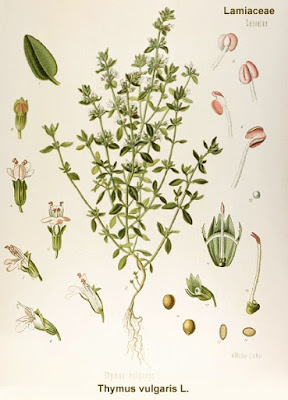 In deze onzekere Coronatijden zoek ik materiële en psychologische steun bij de vele versterkende, immmuunmodulerende en mogelijk anti-virale planten die mij omringen .... vlier, rode zonnehoed, brunel, maar ook vele ontsmettende planten met mosterdolieglycosiden zoals veldkers, daslook, mierikswortel en rammenas zijn nu nuttig. Zelf heb ik ook veel vertrouwen in de mij dierbare lipbloemigen zoals echte salie, rozemarijn, lavendel en vooral tijm. Spijtig genoeg heb ik niet veel verse tijm meer in de tuin, gelukkig had ik nog wat stevige tijmtinctuur in voorraad, die ik nu volop gebruik, puur 5 druppels in de mond mengen met speeksel en dan pas doorslikken.
In deze onzekere Coronatijden zoek ik materiële en psychologische steun bij de vele versterkende, immmuunmodulerende en mogelijk anti-virale planten die mij omringen .... vlier, rode zonnehoed, brunel, maar ook vele ontsmettende planten met mosterdolieglycosiden zoals veldkers, daslook, mierikswortel en rammenas zijn nu nuttig. Zelf heb ik ook veel vertrouwen in de mij dierbare lipbloemigen zoals echte salie, rozemarijn, lavendel en vooral tijm. Spijtig genoeg heb ik niet veel verse tijm meer in de tuin, gelukkig had ik nog wat stevige tijmtinctuur in voorraad, die ik nu volop gebruik, puur 5 druppels in de mond mengen met speeksel en dan pas doorslikken.Om mijn intuïtief, gevoelsmatig vertrouwen in tijm te ondersteunen ga ik maar weer op zoek naar rationele, wetenschappelijke onderbouwing. Het is niet mijn gewoonte om anderstalige teksten van anderen hier te publiceren. Maar nood breekt wet.
Nowadays natural products such as pure compounds and also plant extract scan provide unlimited opportunities for new antiviral drugs (13). Infectious viral diseases have remained important global issues for animals and humans. According to the dependency of viruses on host cells, only a few effective antiviral drugs are available to treat viral diseases. Nowadays finding new substances with intracellular and also extracellular antiviral activities is a need. These substances must affect viruses without harming the host cells. In ovo injection method was designed because studying the plants in vitro and in vivo is time consuming and expensive.. In this method, the plants were first screened for antiviral activity in ovo and then the best plants were selected for the next step.
The amount of active constituents of the plants depend on the geographical distribution, season of collection, and climatic and ecological condition of the collection site (14). Studies show that many plants that are used in traditional medicine to treat viral diseases contain high levels of compounds such as alkaloids, terpenes, flavonoids, naphthoquinones, coumarins and anthraquinones (15). The mechanism of action of these compounds is killing the virus and/or interfering with viral replication. The most important glycoproteins in NDV (Pseudo-fowl pest or Newcastle disease) are haemaglutinin neuramidase and fusion proteins, which are necessary for attachment and multiplication. Protease inhibition activity is observed in some substances of these plants, thus these compounds can interfere with the cleavage of these glycoproteins and inhibit virus attachment (15).
T. vulgaris (thyme) has essential oils which contain mixtures of different volatile and lipophilic substances, such as sesquiterpenes, monoterpenes, and phenylpropanoids. These substances have been proposed to be part of the preformed defense system of higher plants (13). Reports indicate that these substances can be active against microorganisms such as fungi, yeasts, viruses and bacteria. The present study revealed that extracts of the plants under study could be active against NDV and reduce virus yield. In another study, T. vulgaris was found effective against HSV-1/HSV-2. This plant, with the help of essential oils, interferes with the virus envelope, and also masks viral components which are necessary for attachment, penetration, or entry into host cells (13).
Chemical analyses of A. millefolium show the presence of essential oils, tannins, flavonoids, sesquiterpene lactones, alkamides, inulin and ascorbic acid in the plant. The essential oil of A. millefolium possesses antioxidant and antimicrobial properties. This plant also reduces virus titer in vivo(16). The NDV is an enveloped virus and presumably these plants deactivate this virus by affecting the virus envelop. These plants could be used as additives in bird food to reduce the effectiveness of the virus; however, this should be proved in vitro and in vivo. https://www.ncbi.nlm.nih.gov/pmc/articles/PMC4138681/
13. Reichling J, Schnitzler P, Suschke U, Saller R. Essential oils of aromatic plants with antibacterial, antifungal, antiviral, and cytotoxic properties--an overview. Forsch Komplementmed. 2009;16(2):79–90. doi: 10.1159/000207196. [PubMed] [CrossRef] [Google Scholar]
14. Rajbhandari M, Mentel R, Jha PK, Chaudhary RP, Bhattarai S, Gewali MB, et al. Antiviral activity of some plants used in Nepalese traditional medicine. Evid Based Complement Alternat Med. 2009;6(4):517–22. doi: 10.1093/ecam/nem156. [PMC free article] [PubMed] [CrossRef] [Google Scholar]
15. Bakari GG, Max RA, Mdegela RH, Phiri EC, Mtambo MM. Antiviral activity of crude extracts from Commiphora swynnertonii against Newcastle disease virus in ovo. Trop Anim Health Prod. 2012;44(7):1389–93. doi: 10.1007/s11250-012-0076-6. [PubMed] [CrossRef] [Google Scholar]

Geen opmerkingen:
Een reactie posten